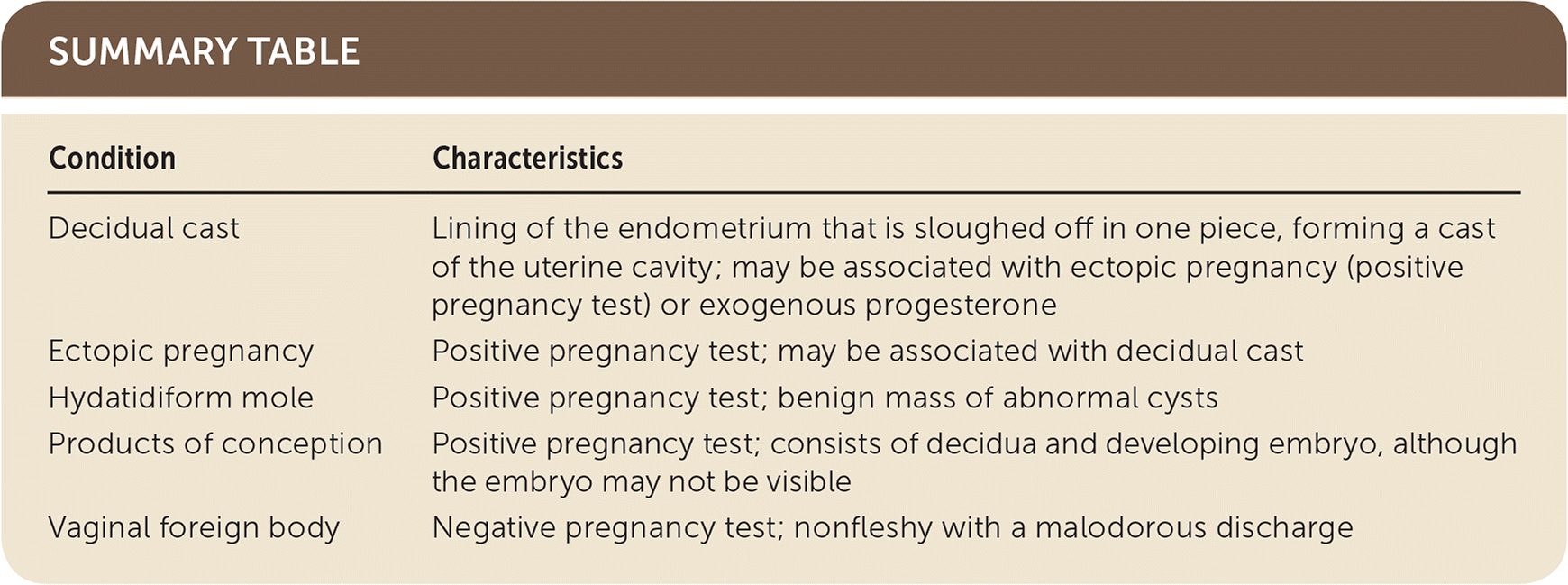
Fleshy Mass Passed Vaginally by a Young Woman
Am Fam Physician. 2018;98(7):449-450
Author disclosure: No relevant financial affiliations.
A 19-year-old nulliparous woman presented with two days of worsening crampy lower abdominal pain. She had vaginal spotting over the previous week but no urinary symptoms or other vaginal discharge. She was sexually active and started medroxyprogesterone (DepoProvera) six weeks earlier. While the physician was obtaining the history, the patient developed intense pelvic pain and excused herself to the bathroom where she passed a bloody, fleshy mass vaginally (Figure 1). The mass was 5 cm × 6 cm × 1 cm. The pelvic discomfort completely resolved after the mass was passed.
On physical examination, her vital signs were normal. Her abdomen was nontender and non-distended with normal bowel sounds. There was no hepatosplenomegaly or costovertebral angle tenderness. A pelvic examination demonstrated a small amount of blood in the vault, but no cervical discharge or cervical motion tenderness. Her uterus was normal size with no adnexal mass or tenderness. A urine pregnancy test result was negative.

Question
Discussion
The answer is A: decidual cast. The decidua is the thick lining of the uterus that forms as a result of progesterone. A decidual cast occurs when the lining of the endometrium is sloughed off in one piece, forming a cast of the uterine cavity.1 The pain that is associated with passing the decidual cast through the cervix is known as membranous dysmenorrhea.2 Decidual cast formation can be associated with ectopic pregnancy or, less commonly, exogenous progesterone. Decidual casts have been attributed to use of oral contraceptives, injectable progesterone, or an implantable progesterone delivery system (Nexplanon).3 Transvaginal ultrasonography should be obtained to ensure there is no residual endometrial mass.
Ectopic pregnancies are pregnancies that implant outside of the uterine cavity. They are most common in the fallopian tube but can be located in the ovary or the abdominal cavity.4 Because a rupture may be life-threatening, ectopic pregnancy must be ruled out in patients with decidual casts.
Hydatidiform moles are benign tumors formed by a nonviable fertilized egg.4 Instead of normal placental tissue, a mass of abnormal cysts form. A pregnancy test would be positive.
Passage of products of conception after a spontaneous abortion would include the decidua and the developing embryo, although the embryo may not be visible. A pregnancy test would be positive, with an empty uterine cavity on ultrasonography after passage of the products.
Vaginal foreign bodies are common, particularly forgotten tampons. Foreign bodies are not fleshy in nature and are associated with a mal-odorous discharge.

| Condition | Characteristics |
|---|---|
| Decidual cast | Lining of the endometrium that is sloughed off in one piece, forming a cast of the uterine cavity; may be associated with ectopic pregnancy (positive pregnancy test) or exogenous progesterone |
| Ectopic pregnancy | Positive pregnancy test; may be associated with decidual cast |
| Hydatidiform mole | Positive pregnancy test; benign mass of abnormal cysts |
| Products of conception | Positive pregnancy test; consists of decidua and developing embryo, although the embryo may not be visible |
| Vaginal foreign body | Negative pregnancy test; nonfleshy with a malodorous discharge |

